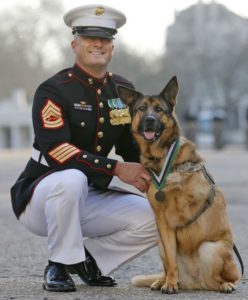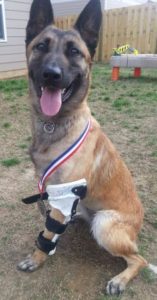By Dr. Beth Leermakers
In honor of Labor Day, let’s celebrate working dogs. You’re probably aware of the important tasks performed by police and military dogs — drug and explosives detection, search and rescue, and the like. But did you know that dogs are often used to hunt for truffles? Or that dogs play an important role in wildlife conservation efforts? Let’s examine a few unusual jobs performed by specially trained working dogs.

Photos courtesy of Pinterest
Military dogs save lives by detecting explosives, performing reconnaissance missions (wearing surveillance cameras) and attacking intruders, among other duties. Multi-purpose canines (MPCs), used in Special Operations teams, perform even more incredible, death-defying feats. MPCs make tandem parachute jumps with their handlers or rappel with their handlers from helicopters. All Navy SEAL dogs are trained to ride in and jump out of aircraft, wearing special harnesses and muzzles that protect their mouths when they land. Cairo, a SEAL dog, is famous for his participation in the raid on the Bin Laden compound. On that mission, Cairo helped secure the perimeter of the bin Laden house, sniffed out bombs and attacked enemy combatants when necessary. He wore a Kevlar vest with harnesses for rappelling and parachuting and a night-vision camera with a 180-degree field of vision.
Layka, another canine military hero, parachuted with her handler in Afghanistan. Despite being shot four times by the enemy, Layka attacked and subdued the shooter, saving the lives of her handler and his team. After losing a leg during her life-saving surgery, Layka retired from duty and was adopted by her handler. Layka continued skydiving, testing canine harnesses to help other canine soldiers reach remote locations.
Because of their keen sense of smell, dogs are widely used to detect drugs and bombs. Some canine super sniffers pursue culinary delicacies instead of illicit substances. Dogs have replaced pigs as truffle hunters because dogs are easier to train and, unlike pigs, dogs won’t eat the truffles. For truffle hunters who want to keep the truffles’ location secret, dogs are less obvious companions. If someone is out walking in the woods with a pig, people will know what they’re doing. Lagotto Romagnolo, Italian dogs bred for truffle detection, are the premier hunters. However, any dog with a solid nose can succeed at the job. Search and rescue dogs, who’ve been trained to detect certain scents, are particularly well-suited for this work.

Dogs’ noses also play an important role in wildlife conservation. Dogs were first used in conservation in the 1890s, when they helped locate two New Zealand bird species. Until the 1990s, conservation detection efforts focused primarily on finding live birds.
Recently, conservation detection has evolved to include the detection of live wildlife, carcass detection for birds and bats around wind turbines, and location of scats, pathogens and other biological materials.
One of the best ways to determine population sizes and the success of reintroduction projects for endangered species is to perform DNA tests on animal scats (feces). Dogs can be trained to locate the scat of specific endangered animals, including tigers, spotted owls, bears, wolves and jaguars.
Dogs can also be trained to detect weeds before they break the surface, preventing the invasive plants from blocking native plants and destroying the ecosystem.
Studies have found that conservation detection dogs are more efficient than several other survey methods in detecting the presence/absence and relative abundance of plants and wildlife. Dogs are key players in the fight against wildlife poaching in Gabon and Tanzania.
Dogs can sniff out ivory, shark fin and animal pelts at roadblocks, airports and train stations. They can also track poachers from a fresh kill.
This Labor Day, as I’m relaxing with my non-working dogs, I’ll take a few minutes to appreciate the extraordinary efforts of hard-working hounds. Happy Labor Day!
